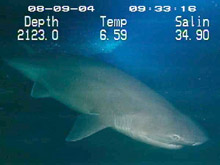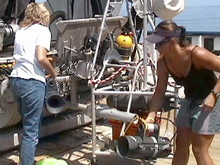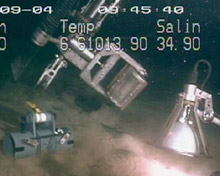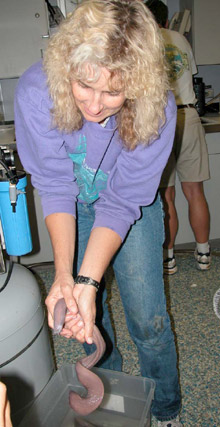
This six-gill shark was captured on video this morning, when the team dove to recover the Eye-in-the-Sea camera system. Click image for larger view and further details.
![]() Click here to see this magnificent shark in motion.
Click here to see this magnificent shark in motion.
Disgusting Hagfish and Magnificent Sharks
August 9, 2004
Tammy FrankBiological Oceanographer
Harbor Branch Oceanographic Institution
Hagfish play an important role in the ocean’s ecosystem, getting rid of (e.g., eating) decaying material on the sea floor. As a biological oceanographer, I'm intrigued by the functions lifeforms perform in the deep. This does not mean, however, that I enjoy being up close and personal with hagfish, as my graduate student Nicole McMullen and I were last night.
Our benthic traps had been down in the mussel beds around the Brine Pool for six hours, and were recovered on the evening dive. The magnesium links (that temporarily kept them open) had worked perfectly: all the traps were closed, when the submersible picked them up. In the closed position, the traps protected any animals inside from the blinding lights of the sub.
Nicole and I carried the traps to the light-tight cold room, where we excitedly opened them under dim red light. Instead of seeing beautiful shrimp and crabs with glowing eyes, we saw blind hagfish heads poking up at us from the traps.

Tammy Frank and Nicole McMullen load baited benthic traps in the front basket of the Johnson-Sea-Link for the long journey to the dive site, over 2,000 ft below. Click image for larger view.

The mechanical arm of the Johnson-Sea-Link places a baited benthicnk trap on the sea floor, just outside the Brine Pool. Click image for larger view.
Hagfish have remnants of eyes, with small lenses, but no retinas. They are essentially blind, and, therefore, pretty useless to a visual ecologist. What makes them truly disgusting is the enormous quantity of mucus they can excrete, when stressed. As we experienced, this is an extremely effective predator deterrent: we quickly returned them to the environment from which they came.
This morning, I completed my first dive on the Brine Pool. Our mission goals were to measure light in the water column; deploy the benthic (bottom dwelling) traps (hopefully, in a hagfish-free zone -- if such a place exists); and bring Edie Widder’s Eye-in-the-Sea (EITS) camera back to the surface. We reached the bottom and motored to the EITS. As we approached, we saw a big object moving around it. It turned out to be a 15-ft, six-gill shark (Hexanchus griseus)! I felt truly privileged to see such a huge predator in its natural environment. Seemingly unbothered by our presence, the shark swam back and forth in front of the camera, before swimming beneath the sub. Finally, it discovered the EITS bait bag (covered with uubiquitous hagfish!). We captured all of this on the sub’s video camera.

Dr. Frank holds a hagfish caught in one of the benthic traps. These fish appear to be prevalent at the Brine Pool. Click image for larger view.
After the shark encounter, we looked for a good place to deploy the baited benthic traps we were carrying. The mussel beds around the Brine Pool are covered with hagfish, so we placed the traps on its periphery, in hopes of trapping fewer hagfish and perhaps a crab or two. Remarkably, hagfish were even swimming in the Brine Pool, which is four times saltier than seawater. On other expeditions, scientists have taken pictures of dead fish floating up in the brine; hagfish must have a remarkable salt tolerance.
We placed the traps in two different locations, then motored back to pick up the EITS camera. On the way, I saw several hagfish swimming happily toward my traps. Sigh. The glamorous life of a marine biologist . . .























